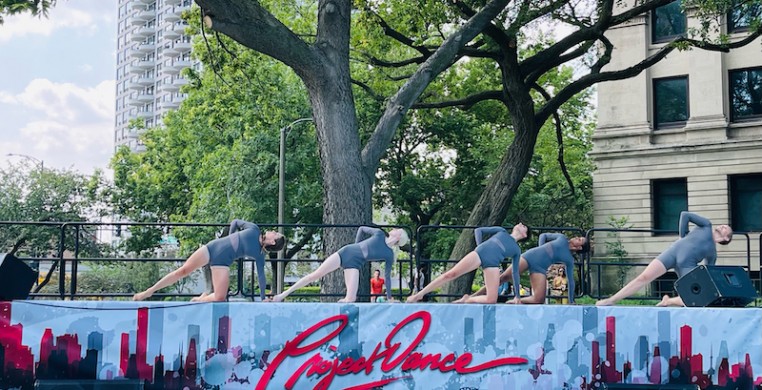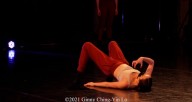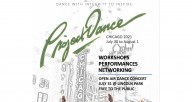Last Saturday, if you were out and about and enjoying the beautiful sunny weather while strolling along a tree-lined thoroughfare near the Lincoln Park Zoo, you would no doubt become allured, as I was, by the sound of music coming from an open clearing just across the road from the landmark Café Brauer. Emerging from beyond the trees, you would have found a large, rail-lined stage engulfed in sunlight, atop which waves of dancers in flowing, robe-like costumes of mauve, turquoise and taupe leapt and pleaded towards the heavens with pointed toes and outstretched fingertips, surrounded by a decent-sized crowd of cheering spectators.
This outdoor congregation was a presentation of Project Dance, a North Carolina-based dance production company founded and directed by Cheryl Cutlip, whose mission is “to bring hope and healing to the world through the universal language of dance.” Production support also came from a Chicago-based non-profit, Identity Performing Arts, with founder Ginny Ching-Yin Lo credited as the producer of the event. Free to the public, Project Dance offered up a whopping 85-minute program featuring a smorgasbord of styles, influences and ability levels ranging from amateur youth to semi- and seasoned professionals from throughout the country—or so I gathered from a flyer. The stacked performance of what I’m guessing must have been 20+ acts ran in a loop from 11am to 4pm—the show ended with a full-company production number followed by a cheeky sample of Porky Pig saying, “Th-Th-That’s All, Folks!,” and then, like a snake eating its tail, begins right back at the top with no break to separate the beginning from the ending.
The bulk of the numbers were made of amateur group works and, to a lesser extent, solos, duets and small groups, of contemporary ballet set to Christian contemporary pop music and updated, stylized hymns—think Natalie Grant or Zach Williams—that paired well with the sun-drenched pastoral setting of the park. These lyrical pieces—that is, dance that draws as much from a song’s lyrical content as it does from its rhythmic or melodic content—contain a certain level of homogeneity and predictability in both music and movement and similar choreographic trends quickly become apparent: any mention of God, of which there are many, almost always elicits a delicate, outstretched and searching fingertips oriented towards the sky; on the lyric “with every breath,” wrapped arms unfurl in a cross-like stance as the dancer’s chest contracts and then expands upward. The stage presence during these numbers was immaculately joyous and unmanufactured, their orientation geared as much upwards towards the heavens as it was downwards toward the Earth.
Not every sacred-themed piece employed lyricism as its main inspiration. Some instrumental numbers picked up the pace, switching from syrupy, suspended hymnal ballads to driving, repetitive, Phillip Glass-like postmodern instrumentals. The repetitive rhythm drove a flock of lithe and virginal-looking figures dressed in pure white gowns and carrying brightly colored bouquets as they chasséd from one end of the stage to another like bridesmaids caught up in the romance and mysticism of a wedding, each one aching to one day attain that level of immortal happiness from both a pact with God and a forever human companion. Each phrase in this work ends nearly the same, with a stage-spanning en masse glissade that ends with a flourish of the legs, either a slow but high développé, a sharp grand battement, or a sustained and angular arabesque turn. Other dances in this vein can be described as nothing more than costume palette swaps, with the overarching choreographic content and pervading joyful and exuberant energy more-or-less the same.
That’s not to say that there wasn’t some variety. Waukegan-based dance company “Alats”—a Hebrew word meaning “to jump for joy”—performed an African-inspired folkdance set to what sounded like South African Gospel music and styles that switched between intricate and syncopated upper-appendage shape-making and weight-forward, relaxed communal step dancing. Contemporary modern dance company “Identity” represented, for me, a more familiar Chicago concert dance aesthetic: focused and furrowed brows belay spine-bending reverse leaps and creepy, spider-like clusters as agile bodies in mono-colored bodysuits morphed and became static structures bent low and freezing as if turned to stone by Medusa’s gaze. Lest the program is taken too seriously in either the joy or angst departments, there were moments of crowd participation during bouts of inclusive modern folk dances, like the “Cha-Cha Slide,” the “Cupid Shuffle” and whichever is the one that goes “left, right, left, left, kick, kick, right-right-right…”
Informal shows like this have been popping up to help ease the pain for those eagerly awaiting the return of a normal, post-COVID concert dance season. Although a nice diversion, mixed-bag programs like this one fall short of scratching the itch. But, if you find yourself, as I did, discovering a proscenium of swaying trees framing a sunlit stage atop which jewel-toned and smiling figures joyously extend and release towards the celestial heavens, you can’t blame yourself for becoming swept up in the jubilance and positivity of legitimate praise dance, as I was.



